Myaskovsky Symphonies Nos 1 & 25
Svetlanov’s admirable survey of challenging symphonies continues to surprise‚ delight and reward
View record and artist detailsRecord and Artist Details
Composer or Director: Nikolay Myaskovsky
Genre:
Orchestral
Label: Olympia
Magazine Review Date: 4/2002
Media Format: CD or Download
Media Runtime: 78
Mastering:
DDD
Catalogue Number: OCD731

Tracks:
| Composition | Artist Credit |
|---|---|
| Symphony No. 1 |
Nikolay Myaskovsky, Composer
Evgeni Svetlanov, Conductor Nikolay Myaskovsky, Composer Russian Federation Academic Symphony Orchestra |
| Symphony No 25 |
Nikolay Myaskovsky, Composer
Evgeni Svetlanov, Conductor Nikolay Myaskovsky, Composer Russian Federation Academic Symphony Orchestra |
Author:
Health permitting‚ Neeme Järvi may yet produce his promised Miaskovsky intégrale‚ but the Olympia label has preempted that project by obtaining the rights to a rival symphony cycle recorded over many years by the veteran Evgeny Svetlanov. From 1965 until 2000 this legendary figure survived changes of nomenclature and nomenklatura to remain chief conductor of the band featured on these discs. Sometimes it sounds as though a shortage of cash and rehearsal time has impacted on standards‚ but the depth of string tone can impress even when you sense that the players aren’t quite sure what’s coming next! If nothing else‚ the complete set will document a forceful and unrefined orchestral sonority that is unarguably ‘authentic’ and fast disappearing.
By no means standard repertoire even in Russia‚ Nikolai Yakovlevich Miaskovsky (18811950) is probably best known these days as Prokofiev’s friend and confidant‚ the distinguished teacher of Kabalevsky‚ Khachaturian and Shebalin – in short primarily a historical figure. For many years only the glorious Cello Concerto (194445) has kept his name alive. This may be because‚ in an age obsessed with the circumstances of creation almost at the expense of considerations of musical substance‚ Miaskovsky’s idiom does pose problems. He reached musical maturity in the most turbulent period of his country’s history‚ staying put (unlike his friend Prokofiev) to witness all the revolutionary upheavals of the Soviet state. It was probably the cultural clampdown of the 1930s under Stalin which had the most impact‚ a lifethreatening blast of isolationism and chauvinism as decisive in its way as the Bolshevik coup of 1917 and the collectivisation imposed from 1928.
So can Miaskovky’s quiet quest for lucidity‚ through a series of 27 symphonies‚ be put down to mere ideological conformity? In his life and pedagogical work‚ he posited the eternal verities of the Russian musical tradition‚ which‚ for him‚ meant achieving an ‘academic’ balance of Romantic passion and Classical limpidity. As with Taneyev‚ there isn’t even anything particularly Slavic about his own style‚ merely a desire to ‘transmute personal experiences into universal communication’. No flagwaving and no subtext either.
Olympia would seem to be giving us a broadly chronological sequence‚ a boon for the collector‚ except that the first three symphonies tend to swamp their fresher ideas in pages of earnest sequential writing. Such music was once considered ‘difficult’. In retrospect the freely modulating chromaticism and tortuous thematic manipulations have as much to do with Liszt‚ Franck and Reger as with the more fashionable Scriabin. The twomovement Third is the best‚ or at least the most Russian‚ of them. All the same‚ the main interest lies with the couplings. Of these‚ the astonishing 13th Symphony (1933)‚ a onemovement piece unsurprisingly censured as ‘dark‚ gloomy‚ nervouslyexpressive and in places weighed down by depression’‚ is an extreme example of the composer’s modernist vein. There is here a selfconscious striving after philosophical depth and a complete avoidance of superficial rhetoric. Indeed‚ its extreme harmonic ambiguity and radically attenuated texture reminded me of late Schnittke rather more than the ‘constructivism’ of Prokofiev and Honegger. This is its first commercial recording. By contrast‚ the 18th (1937) is easy listening‚ a mélange of diatonic folksong designed to commemorate the anniversary of the October Revolution in the manner appropriate at the height of the Terror. The 25th (1946‚ revised 1949) shares a slow‚ fast‚ faster‚ threemovement scheme with Shostakovich’s Sixth‚ though stylistically the works are far apart. Admirers of Miaskovsky’s Cello Concerto will adore the main lyrical idea and perhaps regret its overinflated return. There is just the merest whiff of the harmonic asperities lurking in Miaskovsky’s compositional closet.
How to sum up? Even were there commentators prepared to reappraise the composer’s melancholia and dark nostalgia as (fashionably) subversive‚ many listeners would find Miaskovsky unfathomably dull. For others‚ a minority perhaps‚ that curiously cool and selfabnegating manner (plus‚ for UK audiences‚ the accidental resonances of Elgar and even Bax) can exert a profound appeal. Of the present batch‚ only the recording of No 3 has been available domestically so the appearance of these decently annotated volumes is indeed a cause for rejoicing. They may also change our image of a maestro whose earlier style was thought to be characterised by brash excitement rather than lofty contemplation. His sustained efforts on Miaskovsky’s behalf hint at another side‚ for this is scarcely music which yields its secrets at first hearing or elicits easy applause.
Discover the world's largest classical music catalogue with Presto Music.

Gramophone Digital Club
- Digital Edition
- Digital Archive
- Reviews Database
- Full website access
From £8.75 / month
Subscribe
Gramophone Full Club
- Print Edition
- Digital Edition
- Digital Archive
- Reviews Database
- Full website access
From £11.00 / month
Subscribe
If you are a library, university or other organisation that would be interested in an institutional subscription to Gramophone please click here for further information.




